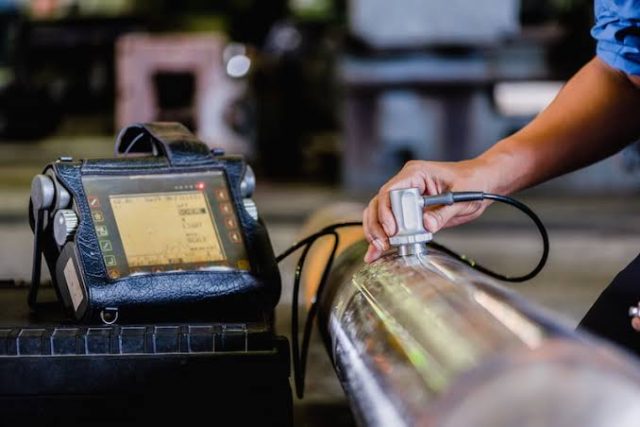CONVENTIONAL NDT
- VISUAL INSPECTION (VT)
- LIQUID PENETRANT TESTING (PT)
- MAGNETIC PARTICLE INSPECTION (MPI)
- RADIOGRAPHIC TEST
- ULTRASONIC TESTING (UT)
- EDDY CURRENT
Visual Inspection (VT)
Visual Testing (VT) is based on the inspection for flaws that are visible to the naked eye and is the most commonly used NDT method across all industries. It allows for a feasible and fast control of quality at every step of the fabrication or maintenance process.
Visual Testing (VT) is used to detect visible flaws such as deformation, welding defects and corrosion. Many tools can be used during the inspection such as a ruler, gauges, cameras, etc. PRIME-TOP INSPECTION has visual Inspectors certified to various codes such as AWS, API, ANSI, ASME, CSWIP, PCN, ISO and ASNT.
Liquid Penetrant Testing (PT)

Liquid or dye penetrant testing (PT) is a non-destructive material testing method which uses capillary forces to find surface cracks or pores and make them visible. It can detect surface-breaking flaws such as cracks, laps, porosity.
The dye penetrant test is usually performed with a red dye penetrant, which can be done in daylight. Whereas the fluorescent dye penetrant test uses a fluorescent test agent, which is much easier to evaluate in darkness or under UV light.
Liquid penetrant testing can be applied to any non-porous clean material, metallic or non-metallic, but is unsuitable for dirty or very rough surfaces. Surface cleaning is a vital part of the penetrant testing technique. The method can be manual, semi-automatic or fully automated. Penetrant inspections on continuous-operation production lines in which the specimens are cleaned, dipped, washed and dried on a time cycle are common.
Magnetic Particle Inspection (MPI)

Magnetic particle Inspection (MPI) is a nondestructive testing (NDT) process for detecting surface and shallow subsurface discontinuities in ferromagnetic materials such as iron, nickel, cobalt, and some of their alloys. The process puts a magnetic field into the part. The piece can be magnetized by direct or indirect magnetization. Direct magnetization occurs when the electric current is passed through the test object and a magnetic field is formed in the material. Indirect magnetization occurs when no electric current is passed through the test object, but a magnetic field is applied from an outside source. The magnetic lines of force are perpendicular to the direction of the electric current, which may be either alternating current (AC) or some form of direct current (DC) (rectified AC).
The presence of a surface or subsurface discontinuity in the material allows the magnetic flux to leak, since air cannot support as much magnetic field per unit volume as metals
To identify a leak, ferrous particles, either dry or in a wet suspension, are applied to a part. These are attracted to an area of flux leakage and form what is known as an indication, which is evaluated to determine its nature, cause, and course of action, if any.
Radiographic Test

Radiography test is a modality of non-destructive testing that uses ionizing radiation to inspect materials and components with the objective of locating and quantifying defects and degradation in material properties that would lead to the failure of engineering structures. It plays an important role in the science and technology needed to ensure product quality and reliability. Industrial Radiography uses either X-rays, produced with X-ray generators, or gamma rays generated by the natural radioactivity of sealed radionuclide sources.
Applications include wall loss detection (profile radiography) and sizing in pipes and plate through to manufacturing defects in welds, forgings castings etc.
Commonly used radioactive isotopes include Iridium 192, Cobalt 60 and Selenium 75.
Ultrasonic Testing (UT)

The ultrasonic testing as an NDT method provides indications of surface and subsurface discontinuities, with the potential to determine the depth and exact size by the use of beams of mechanical waves (vibrations) of short wavelength and high frequency, transmitted from a small probe in contact with the specimen surface and detected by the same or other probes. These Ultrasonic pulses could indicate the presence, absence, and location of flaws, interface and/or discontinuities.
Ultrasonic examination for thickness determination may be made using either the resonance or pulse-echo technique. This technique determines thickness or reveals corrosion discontinuities near the surface or deep within components or structures. Applications include location of manufacturing defects in welds and castings through to Corrosion / Erosion monitoring and large scale corrosion mapping.
Eddy Current
The method Eddy current surface inspection personnel provides Eddy Current Non-Destructive Testing for the detection of surface connected flaws. This NDT technology is based upon the principles of inducing an electromagnetic field into a part and measuring the disturbance to that field by the presence of imperfections. The results are collected to central server and after are defined based upon similar responses to known reflectors in calibration standards. This NDT technique is ideal for nonferrous parts and is capable of inspection through coatings that are intact and smooth.
